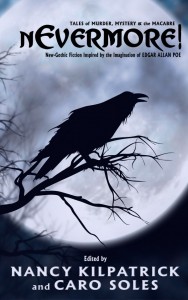
Edited by Nancy Kilpatrick and Caro Soles
Edge Science Fiction and Fantasy Publishing
October 1, 2015
Reviewed by Elaine Pascale
Full disclosure: I have been around the “Poe block” enough times to have a string of hotels installed on whatever his equivalent of Marvin Gardens would be. Now confessed, I can move forward to say that I was genuinely delighted by the originality of Kilpatrick and Soles’ nEvermore. A title claiming “Neo-Gothic Fiction Inspired by the Imagination of Edgar Allen Poe,” would normally send a purist like myself into paroxysms, having been subjected to all manner of “pulpish” Poe inspired stories, graphic novels and films. It was with great relief that I found the presence of Poe looming large in this anthology. Most importantly, the authors truly honor his spirit.
nEvermore features 22 stories, each of them offering a prefaced comment from the author(s) explaining the relationship of the story to one or more of Poe’s works. In tribute to Poe, numerous stories cross genres. In addition, many of the stories sound like Poe: having that flavor that transports a reader to dark library shelves, and books with pages sensitive to light and touch from years of wear.
Some standouts were the stories that contemporized Poe’s works, demonstrating that a good plot has no expiration date. Thomas S. Roche’s “The Masques of Amanda Llado” (love the title) creates a sinister and believable motive for “The Cask of Amontillado,” Robert Bose’s “Atargatis” takes the familial ties of “Fall of the House of Usher” to an incredibly creepy and monstrous level, and Richard Christian Matheson’s “133” adds a dark and satisfying twist to the constant Poe theme of grief. There is also an offering by the adolescent Margaret Atwood – an appropriate throwback as that is the age that most blossoming writers obsess over Poe.
“The Tell Tale Heart” was my first introduction to Poe when I was very young (yes, I had that kind of a childhood) and Christopher Rice’s “Naomi” did the story justice and then some. The backdrop of transgender-phobia mixed with a ringtone used as a guilt trigger was very clever. Rice eloquently sums up the new normal that is our life/death dance with technology: “Tell the world the soundtrack to your daydreams and the world just might do you in over it.” The incorporation of a “trivial” catalyst, yet one that means so much to a certain generation, was a skillful nod to the offensive eye and beating heart of the original.
nEvermore is smart, it is very, very smart, yet it is never too smart for its own good. Kilpatrick and Soles deftly walked the line between having a consistent tone and theme, and maintaining truly diverse and original offerings.
I fully endorse nEvermore for even the most demanding of Poe aficionados. While the book would still be entertaining for those never before exposed to Poe, it is meant for readers familiar enough with his works to understand and appreciate the ways in which the stories intersect and diverge from the originals. It is a well written and shrewdly planned anthology.
- Comic Review: SPILLBLOOD - November 26, 2024
- Book Review: THE BEASTS OF VISSARIA COUNTY - June 18, 2024
- Book Review: DRAW YOU IN - June 14, 2024
- Book Review: WE’RE NOT OURSELVES TODAY - March 21, 2024
- Book Review: QUESTION NOT MY SALT - February 9, 2024
- Book Review: SPEARFINGER - November 29, 2023
- Book Review: THE CTHULHU HELIX - November 7, 2023
- Book Review: LAUNDRYLEGS - September 22, 2023
- Book Review: WICKED SICK - August 20, 2023
- Book Review: UNSPEAKABLE HORROR 3: DARK RAINBOW RISING - August 15, 2023


